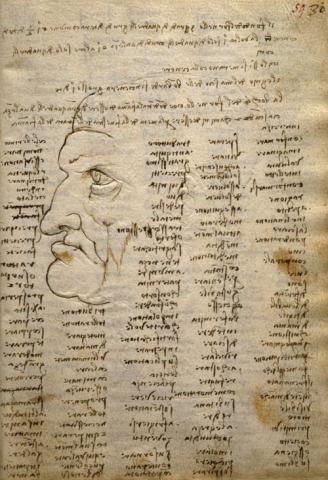Leonardo has been celebrated as an artist since his own time. His work of engineering and therefore all his projects and studies of machines were unknown for years, since the contents of the “codices” only began to be studied and published at the beginning of the 19th century. They are manuscript pages bound together in book form, even if not always Leonardo assembled them in this way. Leonardo arranged his papers, but the manuscripts had not been maintained in that manner: some were divided and sold separately, others rearranged. At present 5000 pages are accounted for in different museums and libraries.
CODEX ARUNDEL
Made up of 238 sheets probably written between 1480 and 1518, it covers art, science, and technology. In addition to studies on geometry, weights, and the properties of water, there are architectural projects for the royal residence of Francois I at Romarantin, and even a description of a prehistoric sea monster. It is the largest of the codices together with the Codex Atlanticus. It is possible to see it in the British Museum.
CODEX ASHBURNHAM
This Codex was original part of Codices A and B, but during the 19th century some drawings were torn out of the original sets and rebound into this Codex. It dates from approximately 1489-1492. The Codex Ashburnham was luckily not destroyed in the fire that destroyed most of the books at the Ashburnham House fire, in 1731. It is possible to see it at the Institute de France.

CODEX ATLANTICUS
The Codex Atlanticus includes a series of twelve leather-bound volumes, once one huge volume, a sort of Leonardo Encyclopedia. This is the largest collection of Leonardo’s manuscripts that has ever been assembled. This Codex consists of studies for some of his paintings, including The Adoration of the Magi, the Battle of Anghiari, and Leda and the Swan. In this collection you can also find some of his designs for robots, sketches for some of his monument projects, and extensive architectural and urban planning layouts. This Codex currently resides at the Biblioteca Ambrosiana in Milan, Italy. These designs and sketches are dated between 1475 and 1480.
CODEX FORSTER
This Codex includes three not too large manuscripts, Forster I, Forster II, and Forster III, which are studies that Leonardo fulfilled between 1490-1505. Remarkable in this set is a large collection of equestrian sketches and references to the equestrian sculpture that was commissioned by the Duke of Milan, Francesco Sforza. The Forster manuscripts were lost for years, but They resurfaced at the end of the nineteenth century and subsequently inherited by John Forster (for which they are named). The Codex Forster was finally given to the Victoria and Albert Museum (London, England) in 1876, and it remains there to this day.
CODEX LEICESTER
This Codex is the only manuscript by Leonardo da Vinci that is owned by a private party and not an institution. It was bought by Bill Gates in 1994. The manuscript dates from 1506 to 1510 and is made of 72 pages of linen paper with notes on a great variety of subjects, especially studies on hydraulics.